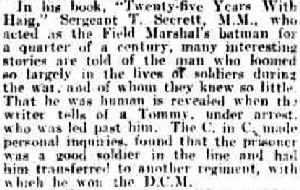Western Mail, Thursday, 29 August 1929, p. 2.
Twenty-five Years with Haig
In his book, "Twenty-five Years With Haig," Sergeant T. Secrett, M.M., who acted as the Field Marshal's batman for a quarter of a century, many interesting stories are told of the man who loomed so largely in the lives of soldiers during the war, and of whom they knew so little. That he was human is revealed when the writer tells of a Tommy, under arrest, who was led past him. The C. in C. made personal inquiries, found that the prisoner was a good soldier in the line and had him transferred to another regiment, with which he won the D.C.M.
Secrett, T., Twenty-Five Years with Earl Haig, Jarrolds, 1929.
Sergeant T. Secrett, M.M. = Sergeant Thomas Secrett, M.M. Thomas Secrett was born in Leiston, Suffolk in 1875, the son of a farm labourer. On 14 February 1892 he enlisted into the 8th Hussars and went to South Africa with them in March 1890. Taking part in several actions, he was for some time a despatch rider for Sir John French. He became personal servant to Colonel Douglas Haig whilst in South Africa, and was to remain with him for 25 years. After the Boer War he was transferred to Haig’s old regiment, the 7th Hussars, but on posting to India in 1909, he was transferred to the 10th Hussars. On returning to England in 1912, he was given his final transfer to the 11th Hussars, with whom he stayed until leaving the Army. Secrett served as Haig’s batman throughout the Great War, his m.i.c. entry showing he entered the France/Flanders theatre on 15 August 1914. For his invaluable service in looking after the Field Marshal in the wartime years, Secrett was awarded the British M.S.M., the French Medaille Militaire and Medal of Honour and the Belgian King Albert Medal. When the Field Marshal relinquished his final command in January 1920, Secrett also left the Army, having completed 28 years military service. He continued to serve Haig as his Valet at Kingston, Surrey. He became engaged to Lady Haig’s maid, and early in 1925 he broached the subject of marriage. The idea was unthinkable to the Earl, who said he could not do without him. With no solution to the impasse, Secrett reluctantly left Haig’s employ and was married in Oct 1925. Earl Haig died on 29 January 1928. In the funeral procession to Westminster Abbey, Secrett preceded the Earl’s charger which was led by troopers of the 17th/21st Lancers and 7th Hussars. The upset caused by Secrett’s departure was later revealed in the Earl’s Last Will (dated 1920), when it was discovered that an annuity to Secrett of £52 was revoked by codicil a year after his departure. A year after Haig’s death, Secrett published a book Twenty-Five Years with Earl Haig, by ‘Sergeant T. Secrett, M.M.’ (the ‘M.M.’ presumably referring to the Medaille Militaire). His service with the Haigs continued and at the time of the Countess Haig’s death in 1939 he was employed as butler to her daughter, Lady Victoria Haig. With the onset of the Second World War, he joined the N.A.A.F.I. on war work. He died on 26 March 1942, aged 62 years, when he suffered a fall when working at a N.A.A.F.I. depot. He and his wife, who died in 1965, were buried in Reigate Cemetery.









